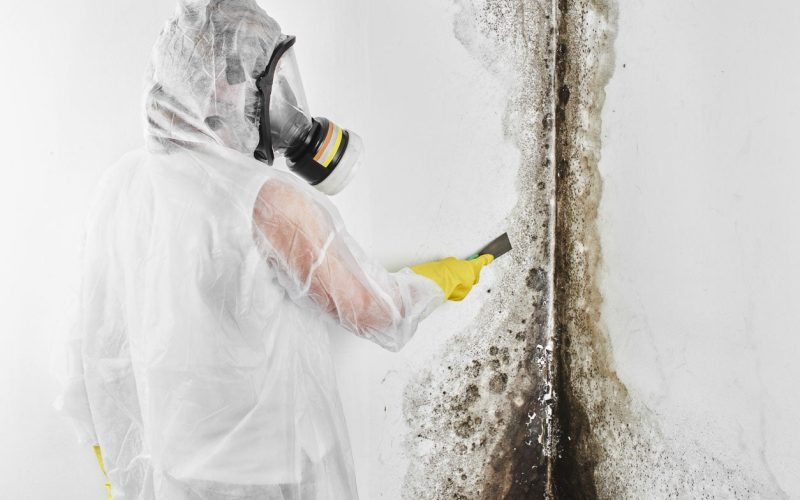If you’re seeking insights into launching a mold remediation business, look no further. This comprehensive guide is designed to equip you with essential steps and valuable information.
Embarking on a mold remediation venture requires meticulous planning, dedication, thorough research, adequate resources, skill development, patience, and some prior experience in the field of remediation.
Given the rising trend of mold remediation due to natural disasters and floods, this business avenue is gaining prominence. If you’re considering entering this sector, this post is your ultimate resource.
Within this article, you’ll gain insights into crafting a meticulous business plan for mold remediation, receive guidance on effective marketing strategies, and become informed about potential risks associated with the industry.
Read Also: How to Sell Gift Cards Online for Instant Cash
What is Mold Remediation Business?
A mold remediation business is a specialized service that focuses on identifying, removing, and preventing mold growth in indoor environments.
Mold can pose serious health risks and also cause structural damage to buildings if left untreated. The primary goal of a mold remediation business is to create healthier and safer indoor spaces by effectively addressing mold-related issues.
The process of mold remediation involves a series of steps:
- Inspection and Assessment: Trained professionals conduct a thorough inspection of the affected area to identify the extent of mold growth and the underlying causes, such as moisture or water leaks.
- Containment: To prevent the spread of mold spores to other areas, the affected space is carefully contained using barriers and negative air pressure systems.
- Removal: Mold-contaminated materials, such as drywall or carpeting, are safely removed and disposed of according to regulatory guidelines. Specialized equipment and protective gear are used to ensure the safety of workers and occupants.
- Cleaning: Surfaces that are salvageable are cleaned using appropriate cleaning agents to eliminate mold and prevent its recurrence.
- Drying and Dehumidification: Addressing the moisture source is crucial to prevent future mold growth. Professionals use dehumidifiers and drying techniques to ensure the space remains dry.
- Preventive Measures: Remediation experts offer recommendations for addressing the underlying causes of mold growth, such as repairing leaks, improving ventilation, and controlling humidity levels.
- Testing and Verification: After remediation, air and surface tests may be conducted to ensure that mold levels are within acceptable limits.
Mold remediation businesses often cater to residential, commercial, and industrial clients. They may work on a project basis, responding to specific mold issues, or offer ongoing maintenance services to prevent mold growth in the future.
Given the potential health hazards associated with mold exposure, mold remediation businesses play a vital role in creating safe and habitable indoor environments. They follow industry standards, safety protocols, and regulations to ensure effective mold removal while safeguarding the health of occupants and workers.
The Type Of Mold Remediation Method:
Mold remediation methods can vary based on factors such as the type of mold, the extent of contamination, the affected materials, and the specific circumstances of each case. Here are some common types of mold remediation methods:
1. Removal and Disposal: For extensive mold growth, the removal and disposal method involves physically removing affected materials, such as drywall, insulation, or carpeting, that cannot be effectively cleaned. These materials are properly sealed and disposed of according to regulations.
2. Surface Cleaning: Non-porous surfaces like metal, glass, and plastic can often be cleaned using appropriate cleaning agents. HEPA vacuums and thorough cleaning techniques help remove mold spores from surfaces.
3. Encapsulation: This method involves using sealants to encapsulate or cover mold-contaminated surfaces. Encapsulation can be effective for preventing mold spores from becoming airborne and spreading.
4. Dry Ice Blasting: Dry ice blasting involves using pressurized air and dry ice pellets to remove mold from surfaces. This method is effective for delicate surfaces and areas where traditional cleaning methods might be challenging.
5. HEPA Vacuuming: High-Efficiency Particulate Air (HEPA) vacuuming uses specialized vacuums equipped with HEPA filters to capture mold spores and prevent them from spreading during cleaning.
6. Biocides and Antimicrobial Treatments: Biocides and antimicrobial treatments are used to disinfect surfaces and prevent mold regrowth. These treatments are often used in conjunction with other remediation methods.
7. Air Filtration Devices: Air filtration devices with HEPA filters can help remove airborne mold spores from the environment, improving indoor air quality.
8. Moisture Control and Dehumidification: Addressing the root cause of mold growth—moisture—is essential. Dehumidifiers and proper ventilation help maintain dry conditions and prevent future mold growth.
9. Professional Testing and Evaluation: Before and after remediation, professional testing and evaluation may be conducted to assess the effectiveness of the remediation process and ensure that mold levels are within acceptable limits.
10. Personal Protective Equipment (PPE): Regardless of the method used, remediation professionals wear appropriate PPE, including respirators, gloves, goggles, and protective clothing, to safeguard their health during the process.
It’s important to note that mold remediation should be carried out by trained professionals who follow industry guidelines and safety protocols. The choice of remediation method depends on the specific circumstances of each situation and requires a thorough assessment by experts to determine the most suitable approach.
How To Start A Mold Remediation Business?
Starting a mold remediation business requires careful planning, knowledge of the industry, and adherence to regulations to ensure effective and safe mold removal. Here’s a step-by-step guide to help you get started:
Research and Education:
Learn about mold, its causes, health risks, and effective remediation methods. Attend workshops, courses, and obtain certifications related to mold remediation.
Business Plan:
Outline your business goals, target market, services offered, pricing structure, and projected expenses. A well-defined business plan is essential for securing financing and guiding your business decisions.
Legal Requirements:
Register your business and obtain the necessary licenses and permits based on your local regulations. Consult with legal experts to ensure compliance.
Insurance
Acquire liability insurance, workers’ compensation (if hiring employees), and other relevant coverage to protect your business and clients.
Training and Certification
Obtain certifications such as the Institute of Inspection, Cleaning and Restoration Certification (IICRC) and other industry-recognized credentials to establish your expertise.
Equipment and Supplies
Invest in necessary equipment like air purifiers, dehumidifiers, HEPA vacuums, personal protective equipment (PPE), and cleaning agents required for mold remediation.
Business Location
Determine whether you’ll operate from a physical location or offer mobile services. Set up a base of operations and secure storage for equipment.
Pricing Strategy
Research competitors’ pricing in your area and set competitive rates. Consider factors like labor, materials, overhead costs, and profit margins.
Marketing and Branding
Develop a professional brand identity, including a logo, website, and business cards. Create a marketing plan to promote your services through online platforms, social media, and local advertising.
Networking
Build relationships with real estate agents, property managers, contractors, and other professionals who can refer clients to your services.
Compliance and Safety
Familiarize yourself with Occupational Safety and Health Administration (OSHA) guidelines and other industry standards to ensure safe practices during mold remediation.
Client Contracts
Create clear and comprehensive contracts outlining services, pricing, warranties, and expectations. Contracts provide legal protection and establish transparent communication.
Initial Jobs
Begin with small-scale mold remediation projects to gain experience and build a portfolio. Positive client reviews and references will help establish credibility.
Documentation and Reporting
Maintain thorough records of inspections, assessments, work performed, and client interactions. Accurate documentation is crucial for liability protection.
Continuous Learning
Stay updated on the latest mold remediation techniques, regulations, and industry trends through ongoing education and training.
Also note that Starting a mold remediation business requires diligence, expertise, and a commitment to ensuring the safety and well-being of your clients. By providing quality services and adhering to professional standards, you can establish a reputable business in the field of mold remediation.
Read Also: Starting a NEMT Company – Profitable Business Plan
Mold Remediation Name Ideas for business
Here are some unique and memorable name for your mold remediation business:
- MoldGuard Solutions
- PureAir Remediation
- MoldMasters Pro
- CleanZone Mold Removal
- EnviroSafe Mold Services
- SwiftMold Remediation
- FreshAir Mold Solutions
- MoldAway Professionals
- Aegis Mold Control
- ClearPath Mold Remediation
- SafeHaven Mold Experts
- MoldFree Restoration
- GreenTech Mold Solutions
- EverClean Mold Services
- VitalGuard Mold Care
- EliteMold Removers
- EcoShield Mold Management
- CrystalClear Mold Solutions
- MoldBusters Restoration
- RenewAir Mold Remediation
How to get a Mold remediation license in Florida
In Florida, mold remediation is a regulated industry, and individuals or businesses providing mold assessment and remediation services are required to obtain a license. The Florida Department of Business and Professional Regulation (DBPR) oversees the licensing process for mold assessors and remediators. Here’s how you can get a mold remediation license in Florida:
1. Determine Your License Type: Florida offers two types of licenses related to mold remediation: Mold Assessor and Mold Remediator. The Mold Assessor license allows you to perform mold assessments, while the Mold Remediator license allows you to perform mold removal and remediation.
2. Meet Eligibility Requirements:
- For a Mold Assessor license: You must have a minimum of a high school diploma or its equivalent.
- For a Mold Remediator license: You must have a minimum of a high school diploma or its equivalent and complete a board-approved training course in mold remediation.
3. Complete Required Training:
- Mold Assessor: Complete a state-approved 40-hour training course in mold assessment.
- Mold Remediator: Complete a state-approved 24-hour training course in mold remediation.
4. Gain Experience (Mold Remediator Only): Before applying for a Mold Remediator license, you need to gain at least one year of practical experience in mold remediation or a related field.
5. Submit Application:
- Complete the appropriate application form for the license you’re applying for, available on the Florida DBPR website.
- Pay the required application fee.
6. Fingerprints and Background Check:
- You need to submit fingerprints for a criminal background check. This can be done through a Livescan service provider approved by the Florida Department of Law Enforcement (FDLE).
7. Proof of Financial Responsibility:
- Provide proof of financial responsibility, such as general liability insurance, to cover potential damages arising from mold remediation work.
8. Exam (Mold Assessor Only):
- Mold Assessors are required to pass a state-administered exam. You will be notified by the DBPR to schedule your exam once your application is approved.
9. Obtain Insurance:
- Mold remediators and assessors must have appropriate insurance coverage, including general liability insurance and errors and omissions insurance.
10. Renewal and Continuing Education:
- Both Mold Assessor and Mold Remediator licenses need to be renewed every two years. You must complete the required continuing education courses before renewing your license.
Remember that the licensing requirements and procedures may change, so it’s important to visit the official Florida DBPR website or contact their customer service for the most up-to-date information before starting the application process.
List of Top 10 Mold Removal Companies
Here are a few companies that were known for their mold removal services in Florida:
- Mold Remediation Pros: Known for their professional mold removal services and comprehensive approach to mold assessment and remediation.
- Mold Zero: Offers advanced mold remediation methods and focuses on preventing future mold growth through their specialized processes.
- Mold Inspection & Testing Miami: Offers mold testing and assessment services along with comprehensive mold removal solutions.
- AdvantaClean: Provides mold removal and indoor air quality services, emphasizing eco-friendly and non-toxic approaches.
- Servpro: Offers mold remediation services as part of their wider range of disaster restoration services.
- Mold Masters Inc: Known for their expertise in mold removal and remediation services, particularly in the South Florida region.
- BioResponse Environmental Services: Offers mold removal and environmental remediation services, known for their quick response and professional approach.
- Cat 1 Restoration: Provides mold removal and restoration services for both residential and commercial properties.
- United Water Restoration Group: Offers comprehensive mold removal and water damage restoration services across Florida.
- 911 Restoration: Known for their emergency mold removal services and commitment to restoring properties after mold-related incidents.
Remember that the quality of service and customer experiences can vary, so it’s important to thoroughly research and consider multiple options before making a decision. Reading recent customer reviews, checking certifications, and getting multiple quotes can help you choose the best mold removal company for your specific needs.
How Much Does Mold Remediation And Removal Cost?
The cost of mold remediation and removal can vary widely based on several factors, including the extent of the mold growth, the size of the affected area, the type of mold, the location, and the specific services required. While I don’t have access to real-time data, I can provide you with a general idea of the cost range for mold remediation based on historical information up until September 2021.
Small-Scale Remediation: For small areas with minor mold growth, such as a bathroom or a small section of a room, the cost might range from $500 to $5,000. These cases usually involve surface cleaning and limited removal.
Moderate-Scale Remediation: For more extensive mold growth in larger areas, such as a basement or multiple rooms, the cost can range from $2,000 to $6,000 or more. This might include thorough cleaning, removal of affected materials, and preventive measures.
Extensive Remediation: Severe mold contamination in large areas or extensive structural damage might cost upwards of $12,500 or more. In these cases, specialized equipment and extensive removal may be necessary.
It’s important to note that these are rough estimates and actual costs can vary significantly based on the factors mentioned earlier. Other factors that can impact the cost include the presence of hidden mold, the need for containment measures, the complexity of the remediation process, and any necessary repairs or reconstruction after removal.
Additionally, some mold remediation companies might offer free inspections, while others might charge for initial assessments. Always request written estimates from multiple reputable companies and make sure they detail the scope of work, the methods to be used, and the associated costs. Remember that choosing the lowest cost option might not always provide the best quality service, so balance cost with the company’s reputation, expertise, and customer reviews.
In Conclusion
In conclusion, embarking on the journey of starting a mold remediation business holds significant potential for success and positive impact.
This endeavour requires a combination of expertise, dedication, and adherence to industry standards to effectively address mould-related issues and create healthier indoor environments






